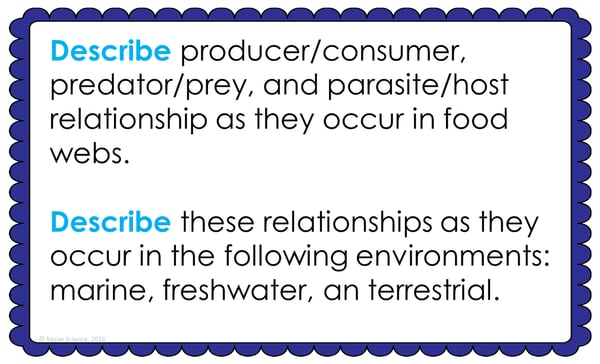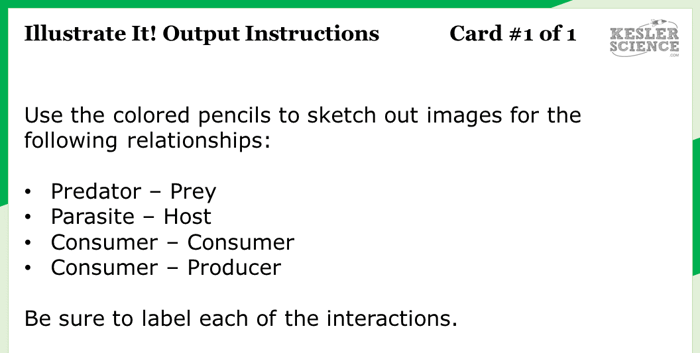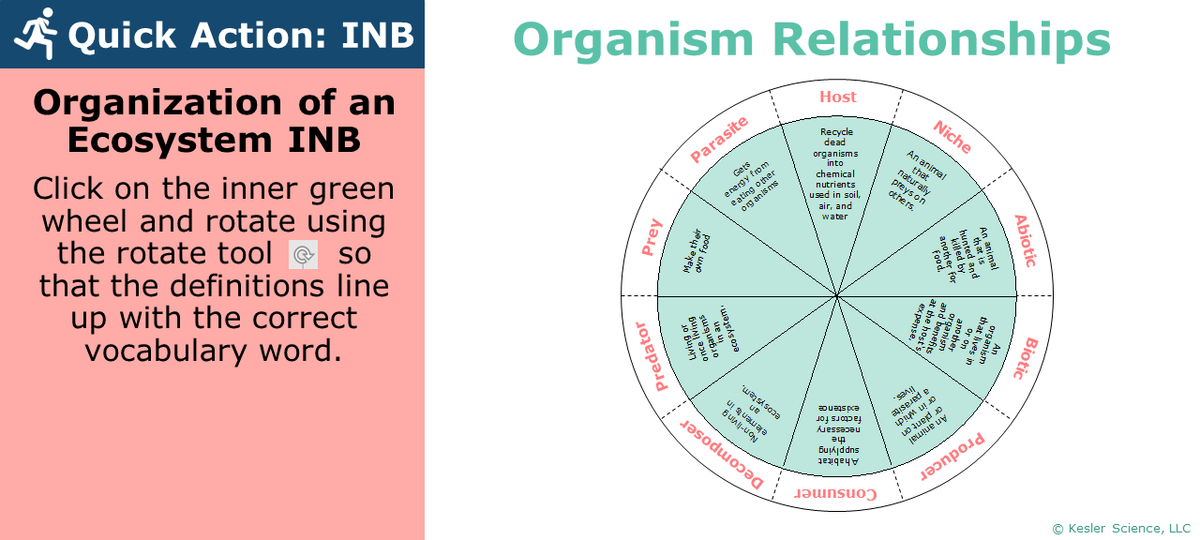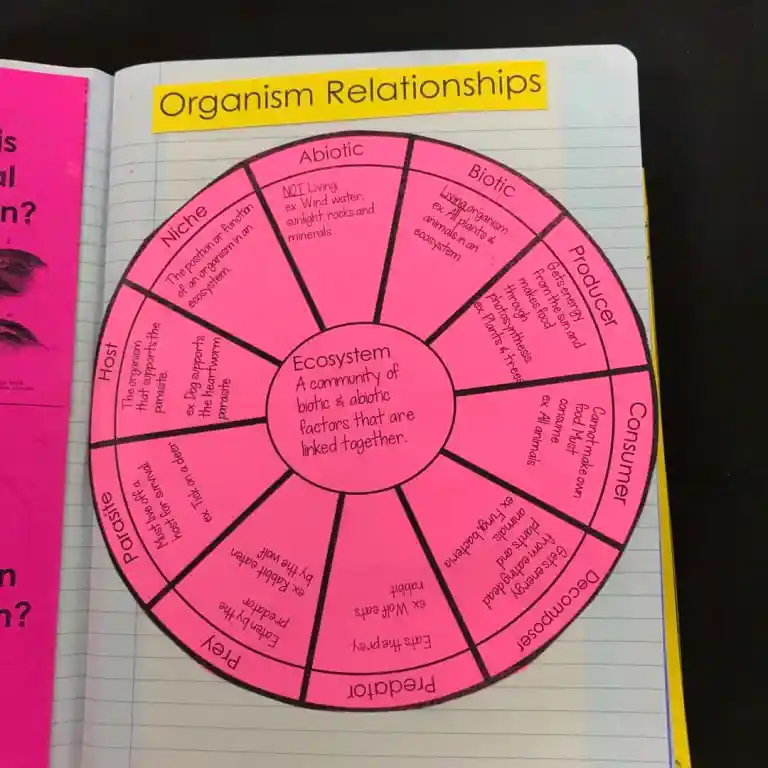Organism Relationships Lesson Plan – A Complete Science Lesson Using the 5E Method of Instruction
By the end of this comprehensive lesson about organism relationships, students will be able to describe producer/consumer, predator/prey, and parasite/host relationships as they occur in food webs. Students will also be able to describe these relationships as they occur in marine, freshwater, and terrestrial environments. Each of our lessons is designed using the 5E method of instruction to ensure maximum comprehension by the students. This well-thought out unit does the heavy lifting, giving teachers easy-to-implement, highly engaging lesson plans.
This blog will walk you through each of the steps and activities from the Organism Relationship 5E Lesson Plan.
ENGAGEMENT
Objective Introduction
At the beginning of the lesson, the class will do a Think-Pair-Share to discuss the objective.
Class Activity
The teacher will ask students what they recall from past predator/prey relationships. The teacher will also ask students to create a T-Chart with predators and prey.
Student Activity
Students will be asked to watch a video. As the video is playing, the teacher will pause it to allow the students time to write down the names of the predators and their prey. After the video is complete, have students list three characteristics for both predators and for prey. Students will share what they have listed on the board. The teacher will put marks when students share the same characteristic and the teacher will add new ones on the board.

The teacher will help to clear any misconceptions about organism relationships. Some major misconceptions are students don’t understand that moving through a food web is all about the energy transfer, and that selective breeding had been going on for centuries.
Estimated Class Time for the Engagement: 20-30 minutes
EXPLORATION
With nine stations in total, you can introduce organism relationships to your middle school students in a variety of ways! Four of these stations are considered input stations where students will learn new information about organism relationships, and four of the stations are output stations where students will be demonstrating their mastery of the lesson's material. A bonus station offers challenges for your early finishers and independent learners. You can read more about how I setup the station labs here.
Watch It!
At this station students will be watching a seven minute video describing and explaining the predator/prey relationships. Students will then answer some questions relating to the video and record their answers on their lab station sheet. For example, describe the relationship between the lynx and rabbit, list three ways in which predators evolved in catching prey, how have plants evolved over time to avoid predators from eating them?
Read It!
This station will provide students with a one-page reading about parasites and hosts. In the reading students will discover what organisms fall into the parasite category. Students will learn about how tapeworms, fleas, barnacles, deer ticks, and aphids attach themselves to another living organism for survival. Students will also learn from the reading that a parasite can either live on their host without too much harm, other will transmit diseases. There are four follow-up questions that the students will answer to demonstrate their comprehension of the reading material.
Explore It!
Students will be working in pairs to analyze organisms in a food web. Students will have students will have to list the producers and the consumers in the web. Students will then list three predator/prey relationships from the food web. Finally students will have to imagine a desert food web and a marine food web and list two more predator/prey relationships.
Research It!
The research station will allow students to skim through an article about parasite and choose one that interests them. Students will then have to summarize the characteristics of their parasite, identify the host to their parasite, and answer why it is so important for us to study parasite/host relationships?
Organize It!
The Organize It station allows your students to place cards into three different categories that relate to the relationships listed on the header cards.
Illustrate It!
Your visual students will love this station. Students will draw images depicting the predator/prey, parasite/host, consumer/consumer, and consumer/producer relationships.

Write It!
Students who can answer open-ended questions about the lab truly understand the concepts that are being taught. At this station the students will be answering three questions to describe predator/prey relationships in their own words and provide an example, explain parasite/host relationships in their own words and provide an example, provide an example of numerous relationships (predator/prey, parasite/host, consumer/consumer, consumer/producer) within an oceanic ecosystem.
Assess It!
The Assess It station is where students will go to prove mastery over the concepts they learned in the lab. The questions are setup in a standardized format with multiple choice answers. Some questions will ask students: what relationship describes vines and trees, what organism relations is described when an organism lives on another to survive, what relations describes a polar bear hunting a seal, and finally which scenario describes a consumer/predator relationship?

Challenge It! - Bonus Station
Early finishers and advanced students will love the extension activities in this station. Four activity choices offer them ways to expand their learning through mini-games and mini-projects.
Estimated Class Time for the Exploration: One or two 45-minute class periods
EXPLANATION
The explanation activities will become much more engaging for your class once they’ve completed the exploration station lab. organism relationships with a variety of materials. These materials include on-level and modified versions of the interactive presentation (may be used individually or projected), anchor charts, and paper or digital interactive notebook activities. If you have students that need modified notes, the 5E lessons come equipped to help give every student access to the lesson.


Interactive notebook samples: Above-left is a digital INB activity slide; above-right is an example of the paper INB activities.
The students will also be interacting with their journals using INB templates for organism relationships. Each INB activity is designed to help students compartmentalize information for greater understanding of the concept. The organism relationships INB templates allow students to focus their notes on vocabulary, levels of organization, and relationship identification.
Estimated Class Time for the Exploration: Two or three 45-minute class periods
ELABORATION
The elaboration section of the 5E method of instruction gives students choices that allow them to prove they’ve mastered the concepts behind the lesson. When students are given a choice, they’re much more enthusiastic and invested in the project than they are when their teachers choose their projects for them. There are a total of nine choices to demonstrate understanding of organism relationships. A separate set of choices that offer more teacher support are also available for students that need them. Rubrics guide students to doing their best work and assist in grading.

Estimated Class Time for the Elaboration: Two or three 45-minute class periods (can also be used as an at-home project)
EVALUATION
The final piece of the 5E model is to evaluate your students' comprehension. Included in every 5E lesson is a homework assignment, assessment and modified assessment. Research has shown that homework needs to be meaningful and applicable to real-world activities in order to be effective. When possible, I like to give open-ended assessments to truly gauge the student’s comprehension.
Estimated Class Time for the Elaboration: One 45-minute class period
DOWNLOAD THE FULL LESSON NOW
Download Over $100 in FREE Resources
For Middle School Science
Simply create a login below and gain immediate access to a selection of our Kesler Science product line worth $100 - for FREE. There's a full version of every product type! You'll also join tens of thousands of middle school science teachers who receive timely tips and strategies straight to their inbox.







